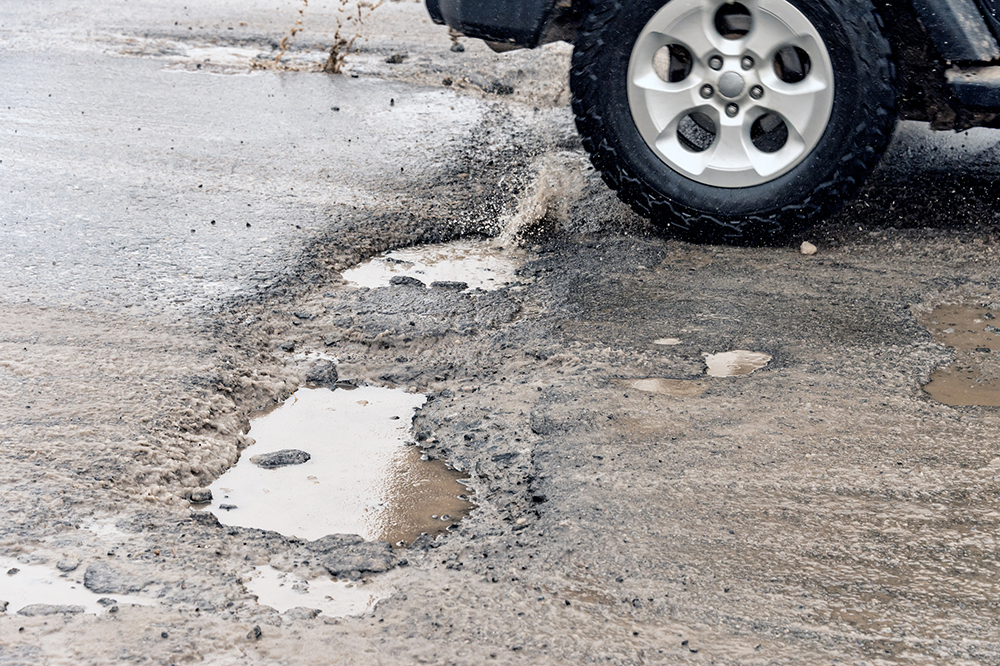Don’t Let Damaged Roads Ruin Your Tires, Vehicle

This winter, Americans are seeing record storms and low temperatures across the country. With these treacherous driving conditions, it is more important than ever to prepare your car for the best possible performance in the snow and cold.
Check Those Tires
Winter weather and roads put a lot of strain on your tires. In extreme cold, the rubber can crack and broken asphalt will do a great deal of damage. Inspect your tires regularly, especially after any difficult or rough drives.
Make sure you stay on top of tire inflation. The cold weather can cause a drop in PSI, so check tires regularly and fill with air when they fall below the proper inflation range. Proper inflation levels for your vehicle can be found inside the drivers-side door.
Potholes And Other Tire Problems
Freezing and thawing of water in the asphalt can cause severe cracks and potholes. Driving over a pothole, even at low speeds, can cause damage to your car including:
- Bent wheel rims
- Alignment issues
- Tire damage
- Shock and strut problems
After you hit a pothole, do a visual check for any damage. Look for harm to the rim or a deflation in the tire as well as any gashes or damage to the rubber.
While you are behind the wheel, make sure there aren’t any strange irregularities in the way your car handles after the incident such as noises, vibrations or steering issues.
Compensations For Pothole Damage?
Did you know that cities and states may pay for damage to your car from potholes on public roads?
Check with your local municipality and submit the proper information, but it’s worth looking into, especially if you reside in a large metropolitan area.
Visit your city’s website to see if they have a pothole program.
The Benefit of M+S Tires
Tires are imprinted with several pieces of information including two special icons. The first is M+S, which stands for mud and snow. This symbol will often appear on all-season tires, but is largely to show the difference between summer tires and all-season.
M+S can be a bit simplistic and viewed as the bare minimum for weather standards.
The second symbol is the three-peak mountain symbol known as 3PMSF. This industry standard signifies that the tire is a proper winter tire and adheres to regulations and standards.
Studded Tires And Chains
Studded tires have small lightweight, metal spikes known as “studs” inserted in the tires. The studs help to break through snow and give the driver better traction on ice. Studded tires are especially beneficial in snow zones and rugged mountain regions with extreme winter temperatures.
Tire chains are usually only necessary on mountain roads or in extreme weather conditions. If you are traveling in high elevations during winter, experts recommend you keep a set of chains in your trunk. Conditions can change quickly and local authorities may implement a chain requirement. Chains are generally not used for regular, day-to-day driving.
For most drivers, studded tires and chains aren’t necessary unless you live in an area with extremely harsh winters.
Beware: Some states have laws and limitations against studded tires due to the damage they can inflict on roadways.
Tips to prevent tire damage
- Stay alert while driving and keep an eye out for potholes, hazards and, of course, other drivers.
- Watch your speed, always have control of your vehicle and know “exit routes” to get out of potential danger.
- Don’t rush through puddles. You never know how deep they might be and there is the potential for hydroplaning.
- Also the wave of water you kick up might temporarily blind you by filing the windshield with a torrent of water.
- Always use four winter tires no matter what type of vehicle you drive. By not using four, you risk uneven traction and the possibility of fishtailing or over steering, even with front wheel drive.
- Winter tires are recommended for drivers who visit or live in climates with snow and ice.
- All-season and all-weather tire rubber may harden due to lower/freezing temperatures. The physical changes caused by cold weather reduces traction and may increase slipping, leading to a loss of control.
- Even if you have 4-wheel drive, winter tires are recommended for drivers who visit areas with snow and ice.